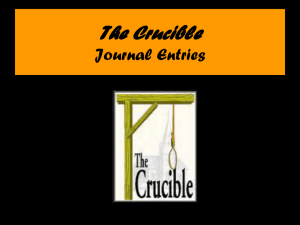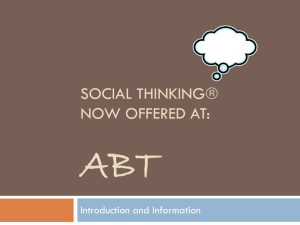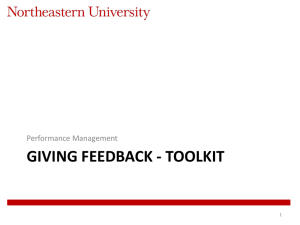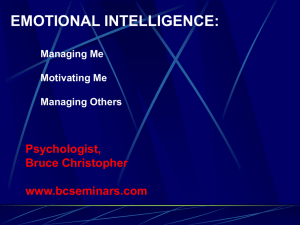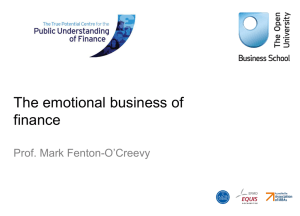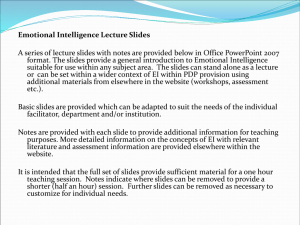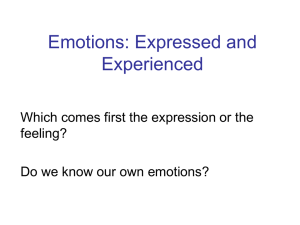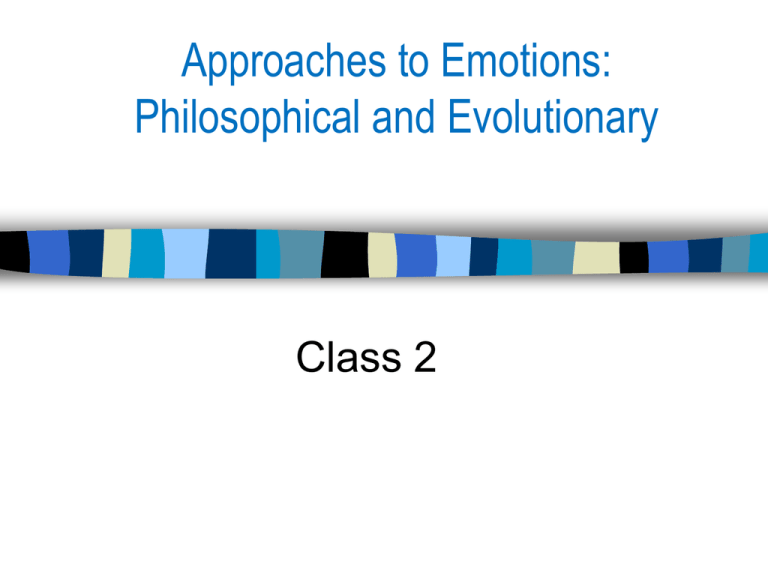
Approaches to Emotions:
Philosophical and Evolutionary
Class 2
Philosophers of Emotion:
Aristotle, Descartes, Spinoza, and Jefferson
Aristotle (384-322 BCE)
* Emotions connected to action
* Emotions follow beliefs but also can shape beliefs
* Emotions tied to narrative, to stories and drama
* Function of tragic theater is Katharsis—clarity
gained by emotional identification with others.
Descartes (1596-1650)
* Mind and body not tied, but separate. Body a machine.
* Emotions occur not in body but in “soul”
* Emotions tell us how events affect our thinking selves.
* Emotions shaped by the way we appraise events.
Spinoza (1632-1677)
* Active emotions —come from loving the world as it is.
• Passive emotions —bitterness, envy—come from rejecting
perfection of universe.
[ACTIVE VS PASSIVE ≈ APPROACH VS. AVOID?]
* People aware of desires, but ignorant of causes
* Emotions stem from how we appraise the world
* Emotions cloud understanding; need to understand emotions
to be free of them.
Thomas Jefferson (1743-1826)
* Influenced by Rousseau “The heart has its reasons that the
reason cannot know.”
* “My Head and My Heart”—elevates emotions to seat of
moral judgment.
•Anticipates “Emotional Intelligence”
•Elevates emotions to fundamental right: “life, liberty and the
pursuit of happiness”
Thomas Jefferson: My Head and My Heart
Vita
1743- July 4, 1826
Drafted Declaration of Independence
Secty. of State (1789-1794)
Vice President (1797-1801)
John F. Kennedy Welcoming Nobel Prize Winners at
the White House:
President (1801-1809)
This is the most extraordinary collection of talent, of
human knowledge, that has ever been gathered
together at the White House, with the possible
exception of when Thomas Jefferson dined alone.
Hobbies: Inventor, architect, farmer
We hold these truths to be self-evident, that all men
are created equal, that they are endowed by their Creator
with certain unalienable Rights, that among these are
Life, Liberty and the pursuit of Happiness.
Jefferson "My Head and My Heart"
Background: Jefferson had affair with Maria Cosway. Artist,
composer, musician, founded girls' school.
Letter is "love letter" upon their separation. Maintained
correspondence for remainder of Jefferson's life.
Letter written as internal dialogue between Jefferson's head
"reason" and heart "emotions" about the pain of separation.
Jefferson had recently broken wrist, wrote letter with left hand,
thus references to "hurt wrist."
Jefferson never married.
Heart
Head
Head: "I never found that the moment of triumph for with you was NOT the moment of attention
to [reason]. While suffering under your follies, you may perhaps be made sensible of them"
Heart: [Hears list of all the problems and bad judgment that came from associating with
Maria, and deceptions heart creates with others to spend more time with Maria].
"Oh my dear friend how you have revived me by recalling to my mind the transactions of
that day!"
Head: "I told you, you were impudently engaging your affections", "I warned you about
separation pain, that there was NO FUTURE, and what chance is there she'll come to
America? Nearly none. Be Realistic. Focus on objective facts.
"You must learn to look forward before you take a step which may interest our peace.“
"Everything in this world is a matter of calculation. "Do not bite the bait of pleasure..."
"The art of life is the art of avoiding pain."
Th. Jefferson: My Head and My Heart
Heart replies:
Let the sublimated philosopher grasp visionary happiness while pursuing
phantoms dressed in the garb of truth! Their supreme wisdom is supreme
folly: they mistake for happiness the mere absence of pain.
Respect for myself now obliges me to recall you into the proper limits of your
office. ...To you [nature] allotted the field of science, to me that of morals.
Morals were too essential to the happiness of man to be risked on the
uncertain combinations of the head.
EXAMPLES: Wounded soldier asking for ride, poor woman asking for
charity. America's bid for independence from Britain:
I do not know that I ever did a good thing on your (head's) suggestion, or a
dirty one without it.
Appraisal and Emotion
APPRAISED SITUATION
EMOTION
I see a truck pulling into my
lane on the highway, and
there’s no space for me to
move over.
FEAR
Trucker hears my horn,
looks down, sees a little red
VW wagon with a
screaming man waving only
one finger at him.
ANGER
Appraisal and Emotion
APPRAISED SITUATION
I see a truck pulling into my
lane on the highway, and
there’s no space for me to
move over.
Trucker hears my horn,
looks down, sees a little
blue Honda Accord with a
screaming man waving only
one finger at him.
EMOTION
FEAR
ANGER
ANGER
Magda Arnold and Sylvan Tomkins
Madga Arnold:
* Role of Appraisal in emotions
* Emotions are relational: self to events, persons, things
Sylvan Tomkins
* Emotions are amplifiers and motivators
* Direct attention to most pressing events in environment
* Facial expressions help shape and accentuate
emotional experience.
Evolution and Emotions
Class 2
Are Emotions Universal?
Do all cultures experience the same emotions?
Do all cultures express basic emotions the same way?
Do cultures differ in how intensely they show emotion,
for the same kinds of events?
If emotions are genetically determined, does culture
play any role in shaping them?
Ekman’s Neurocultural
Theory of Emotion
Paul Ekman
I.
Facial expression for each emotion is set by evolution.
II.
Culture affects emotion in three ways:
1. Determines what kinds of events cause us to
experience emotions.
2. Sets norms for expressing emotion—Display rules
3. Says how to act on emotions.
Ekman's Standardized Emotional Expressions
Judgment of Emotion by Observers in Five
Literate Cultures
(Ekman & Friesen, 1971)
Japan
87
71
87
63
Brazil
97
77
82
82
Chile
90
78
88
76
Argen.
94
68
93
72
USA
97
88
91
69
Disgust/
Contempt
Sadness
82
86
85
79
82
74
82
90
85
73
No. of
Subjects
29
40
119
168
99
Happiness
Fear
Surprise
Anger
Critique of Ekman's "Literate Cultures" Study
1. All cultures share common literature, TV, radio
2. Cultures could influence each others. 50 years ago:
French would never eat Big Macs
Americans would never eat raw fish
Michiganders would not eat "Tah-kohz"
3. How is cultural influence a problem in terms of emotion
recognition as evidence that emotions are universal?
Literate, modern cultures could inform each other about
emotional expression.
Solution???
Pre-Literate Culture Study
Literate cultures share books, movies, therefore get
common understanding of emotions.
Solution?
Study a pre-literate culture.
South Fore People of New Guinea
Study 1 (1967): Show photos, subs. ID emotions. Results a mess.
Study 2 (1968): Ss told story (Aristotle!), pick photo that matches.
Study 3: Fore people make faces = story characters, photo
taken, US College students ID emotions.
A wild boar is standing outside her
hut. What emotion does she feel?
A
B
C
Display Rules
Culturally determined rules about when, and to
what degree, spontaneous emotion can be
publicly expressed.
Design and Results of Ekman Study
on Display Rules
Alone
With another
Japanese
Americans
Expressive
Expressive
Unexpressive
Expressive
New Directions In Emotions Science:
Big Brother “Feels You”, (thanks to Ekman!)
http://www.affectiva.com/technology/
Sensors in phones, TVs, cars, public spaces.
Clients: Verizon, Anheiser Busch (responsive beer bottles!),
ATMs, AOL, eBay, Sony, X Box, Intel, Google, Comcast, etc.)
Program will know your emotions better than you will.
Program can read your inner states, better than you can hide
them.
Welcome to the Brave New World of Emotional Scanning!
Russell’s Circumplex Model
of Emotion
AROUSED
???
???
UNPLEASANT
PLEASANT
???
???
UNAROUSED
Russell’s Circumplex Model
of Emotion
AROUSED
happy
angry
UNPLEASANT
PLEASANT
calm
depressed
UNAROUSED
Other Clues to Universal Nature of Emotions
What are other sources of "data" that people show
same emotions across cultures?
That emotions are "born", not "taught", and are the
same everywhere?
Other Clues to Universal Nature of Emotions
What are other sources of "data" that people show
same emotions across cultures?
That emotions are "born", not "taught", and are the
same everywhere?
1. Infant studies (more on this in later classes)
2. Blind/deaf: a. Same facial expressions
b. Same postures
3. Primate studies
Kent Harber Web Page
http://nwkpsych.rutgers.edu/~kharber/
http://nwkpsych.rutgers.edu/~kharber/emotions/
DO ANIMALS HAVE EMOTIONS?
http://www.youtube.com/watch?v=nGeKSiCQ
kPw
Clues From Primate Studies on
Emotions as Inherited
Jane Goodall’s Chimp Observations
Chimp society based on aggression and sex
Aggression relates to social hierarchies
Aggression in chimps linked to serotonin levels. Same for humans
Chimps appear to be emotional—and to share same basic
emotions as humans.
Jane Goodall: “Emotional states of chimps are so obviously
similar to ours that even an inexperienced observer can
interpret the behavior”.
From Reflexes to Emotion
a. Reflexes
b. Patterns of action
c. Innate releaser/sign stimulus/cue
d. Emotions
Emotions and Action Patterns
Cue
Emotion
Pattern
Purpose
Intruder
Anger, alarm
Aggression,
warning
Defend
territory
Potential
Mate
Excitement,
arousal
Flirtation,
displays,
approach
Mating,
affiliation
Emotions and Problem Solving
Emotions draw attention to problems
Emotions keep attention on problems, until problems are
solved.
Different emotions are keyed to different kinds of problems
EMOTION
“PROBLEM”
“SOLUTION”
Guilt
Betrayal of
another
Restore bonds
Fear
Threat to self
Self Protection

